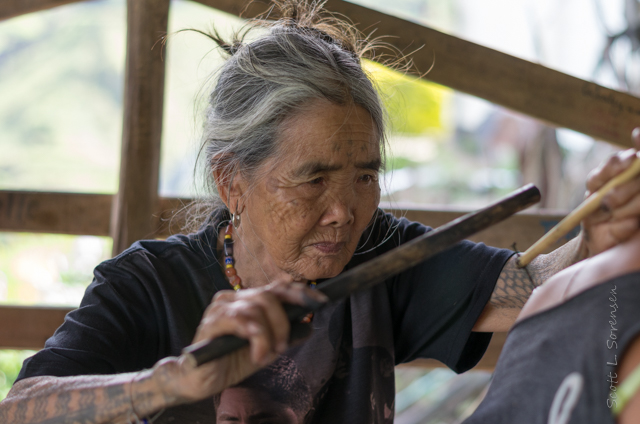
Photo courtesy of Mawg64 / Wikimedia Commons
The debate sparked by the Apo Whang-od, Kalinga tattooing, and Manila FAME expo controversy is a long time coming in a country like ours which is still striving to find a unifying identity in the face not just of local cultural diversity, but acute social inequality.
Two weeks in and opinions are still being voiced out. It seems to me that the major points have crystallized (in general) into two camps. First are those who are for Apo Whang-od’s “agency” in that she and her relatives chose to be at the expo, that they enjoyed their time in Manila, and that they are entitled to that. On the other side are those who say that regardless of individual wants, exploitation still took place given the structural conditions surrounding the event and the wider matter of the place/use of indigenous arts in contemporary society.
I have placed the term “agency” in quotation marks because the way it is being bandied about needs a bit of looking into. As a concept from the social sciences, agency emerged as a response to the rigid structuralist interpretations of culture and society – the school of thought which held that (to put it simply) social and cognitive structures (and the institutions that reflected these, like kinship, political system, religion, etc.) determined the norms and behaviours that people follow to maintain group order.
Agency theory arose not simply to say that individuals have choices, but to assert that even within those so-called structures are the ways by which they could be undermined, improvsed, and changed by people who were nevertheless still enveloped in them. Agentic actions are not just individual decisions on individual desires made in a social vacuum, but dynamic and collective counterpoints to prevailing social conditions acted out (with all the entailing physical, mental, and emotional toll that can be expected) while being enmeshed in it.
The “agency” concept that is then being used in the Whang-od/Manila FAME issue is less agency theory (sensu Sherry Ortner and Karen Barad, to say it in academese) as above, but more good old fashioned liberalism (for individuals) 18th century style. This conceptual clarification needs to be made if we are to move forward and be able to pick some learning up from what happened.
In any case, the flipside of “agency” (or, “personal choice”) is being able to admit full responsibility for actions made under such. Others have already mentioned how Whang-od and/or her community have themselves contributed to the commercialization of the tattoo, perhaps along with other non-Kalinga who have gotten it. (Disclosure: I too have a tattoo by Apo Whang-od that I got way back in 2010, but this is a point that I will apply to myself as well and hope that others like me can think about it too.)
I feel that this may be an unpopular point, but one that is necessary to allow everyone (us in the “mainstream” and indigenous communities) to be a bit more reflexive and to raise the quality and direction of agentic acts a notch higher.
I’ll give one example. As an anthropologist, I do not work in Kalinga, but I do work with other indigenous groups in Southern Mindanao, who, coincidentally enough, were in a similar situation not too long ago.
In the face of mounting protests by various lumad groups (enacted through massive bakwits, and later on, the annual Lakbayan), state agents, politicians and government agencies have accused advocacy groups of “manipulating” the lumad, and the lumad for allowing themselves to be manipulated in turn. The contrasts in both cases are worthy of a full-length discussion of their own (for example, the reversal of roles of the State as accuser and now as promotor, with the National Commission on Indigenous Peoples, the Department of Trade and Industry, and the Armed Forces of the Philippines being actively involved in the Manila FAME event). But let me now just concentrate on how the lumads I work with took this as an opportunity to cultivate their own discourse.
For them, this was a chance not just to simply assert their individual wants and desires per se. Agency is not just a “positive” choice but can also be that of “preferring not to” accommodate state enticements. It can be the acceptance of a weightier burden through linking with other marginalized sectors of society, and to elevate the discussion as to why there is inequality, oppression, and exploitation in the first place.
These actions and realizations did not come without a cost, which is why accusations that they are “brainwashed” are doubly hurtful. Their political actions intensified the contradictions within their own society itself (just like any human grouping, the lumad are not a monolithic entity after all), helped in no small way by tribal “dealers” actively damaging their efforts, and the active recruitment of lumad paramilitary by the AFP. I have seen how their leaders agonized with their kin, as well as within themselves, as some chose a life of exile, or a life on the run.
This, to me, is also agency: the individual and collective lumad finding in their inner selves the need and capacity to grasp solidarity in struggle.
This brings us to the other side of the debate to the very impassioned outburst of sympathy for Apo Whang-od and her situation at the Manila FAME event. I don’t need to repeat the salient arguments for this position, they have been much better articulated elsewhere (like this thought coming from Prof. Roland Tolentino). But what I think should be raised here is a challenge for all those netizens who have spontaneously felt that there was something iffy with the Manila FAME event. After all, exploitation doesn’t just take place in singular, palpable incidents like this one. What do we do about the less-palpable and less-visible forms of exploitation, which are actually more insidious because they can be carried out right under our noses if we are not vigilant?
If we can assert that Apo Whang-od’s own choices be respected, then we can defend the lumad Lakbayanis from the naysayers who call them “manipulated”, “hakot”, and “bayaran”. If we can listen to and believe her when she says that she enjoyed her time in Manila, then we can listen to the lumads when they say that imperialism and capitalist plunder have wreaked havoc on their lands; even if one does not believe them right away, I know that these lumad (even the young students among them) would be more than happy to engage in educative dialogue.
If we can call out Manila FAME and their institutional backers, then we can call out the state-backed impunity that has allowed the killing of lumad leaders, the closure of lumad schools, the harassment of lumad teachers, students, and parents, and the massive bakwits.
If we can try to look for a safe ground by celebrating personal choice, culture change, and respect, then let us also celebrate the culture of principled resistance demonstrated by our national minorities (indigenous and Moro peoples) from the past to the present. Let us also celebrate their struggles – agentic, anguished– to find alternatives to a repressive system dictated by capital, a struggle that is ultimately not just their hope, but also ours.






